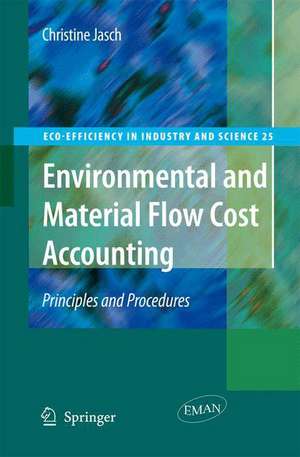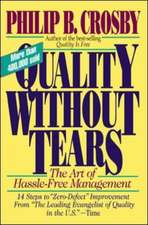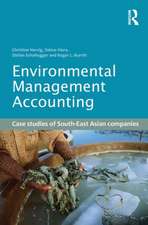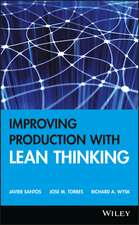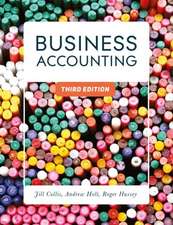Environmental and Material Flow Cost Accounting: Principles and Procedures: Eco-Efficiency in Industry and Science, cartea 25
Autor Christine M. Jaschen Limba Engleză Hardback – 30 oct 2008
“Environmental and Material Flow Costs Accounting” explains and updates the approach developed for the United Nations Department of Economic and Social Affairs (DSD/UNDESA) and the International Federation of Accountants (IFAC) and in addition includes experiences of several case studies and recent developments regarding EMA and MFCA in national statistics and ISO standardization.
| Toate formatele și edițiile | Preț | Express |
|---|---|---|
| Paperback (1) | 636.80 lei 43-57 zile | |
| SPRINGER NETHERLANDS – 22 noi 2010 | 636.80 lei 43-57 zile | |
| Hardback (1) | 643.00 lei 43-57 zile | |
| SPRINGER NETHERLANDS – 30 oct 2008 | 643.00 lei 43-57 zile |
Din seria Eco-Efficiency in Industry and Science
- 9%
 Preț: 901.53 lei
Preț: 901.53 lei - 18%
 Preț: 951.29 lei
Preț: 951.29 lei - 15%
 Preț: 640.24 lei
Preț: 640.24 lei - 15%
 Preț: 654.77 lei
Preț: 654.77 lei - 15%
 Preț: 648.42 lei
Preț: 648.42 lei -
 Preț: 391.61 lei
Preț: 391.61 lei - 15%
 Preț: 642.51 lei
Preț: 642.51 lei - 15%
 Preț: 643.34 lei
Preț: 643.34 lei - 18%
 Preț: 957.62 lei
Preț: 957.62 lei - 18%
 Preț: 953.35 lei
Preț: 953.35 lei - 18%
 Preț: 1238.74 lei
Preț: 1238.74 lei - 18%
 Preț: 1224.68 lei
Preț: 1224.68 lei - 18%
 Preț: 963.15 lei
Preț: 963.15 lei - 18%
 Preț: 2115.07 lei
Preț: 2115.07 lei - 18%
 Preț: 1388.53 lei
Preț: 1388.53 lei - 18%
 Preț: 1855.88 lei
Preț: 1855.88 lei - 18%
 Preț: 1234.94 lei
Preț: 1234.94 lei - 15%
 Preț: 647.40 lei
Preț: 647.40 lei - 18%
 Preț: 1222.01 lei
Preț: 1222.01 lei - 15%
 Preț: 637.59 lei
Preț: 637.59 lei - 15%
 Preț: 648.42 lei
Preț: 648.42 lei - 15%
 Preț: 646.62 lei
Preț: 646.62 lei - 15%
 Preț: 645.79 lei
Preț: 645.79 lei - 20%
 Preț: 590.95 lei
Preț: 590.95 lei
Preț: 643.00 lei
Preț vechi: 756.47 lei
-15% Nou
Puncte Express: 965
Preț estimativ în valută:
123.08€ • 133.73$ • 103.45£
123.08€ • 133.73$ • 103.45£
Carte tipărită la comandă
Livrare economică 21 aprilie-05 mai
Preluare comenzi: 021 569.72.76
Specificații
ISBN-13: 9781402090271
ISBN-10: 1402090277
Pagini: 224
Ilustrații: XXVI, 198 p.
Dimensiuni: 155 x 235 x 17 mm
Greutate: 0.49 kg
Ediția:2009
Editura: SPRINGER NETHERLANDS
Colecția Springer
Seria Eco-Efficiency in Industry and Science
Locul publicării:Dordrecht, Netherlands
ISBN-10: 1402090277
Pagini: 224
Ilustrații: XXVI, 198 p.
Dimensiuni: 155 x 235 x 17 mm
Greutate: 0.49 kg
Ediția:2009
Editura: SPRINGER NETHERLANDS
Colecția Springer
Seria Eco-Efficiency in Industry and Science
Locul publicării:Dordrecht, Netherlands
Public țintă
Professional/practitionerCuprins
Foreword.- Executive Summary.- 1. What is EMA and why is it relevant?- 1.1 The issues behind EMA.- 1.2. Challenges for current accounting practices.- 1.3. Definition of environmental costs and environmental managementaccounting (EMA).- 1.4. Monetary accounting.- 1.5. Physical accounting.- 1.6. EMA Links to Financial, Statistical, Environmental and Sustainability Reporting Requirements.- 1.7. EMA uses and benefits.- 2. The input side of the material flow balance.- 2.1 Overview on material flow balances.- 2.2. Raw Materials.- 2.3 Auxiliary Materials.- 2.4. Merchandise.- 2.5 Packaging.- 2.6. Operating Materials.- 2.7. Energy.- 2.8. Water.- 3. The output side of the material flow balance.- 3.1 Products and by-products.- 3.2. Non-Product Outputs (Waste and Emissions).- 4. Environmental performance indicators.- 4.1 ISO 14031 - Standard on environmental performance evaluation.- 4.2 Environmental performance indicators of GRI.- 4.3 General requirements for indicator systems.- 4.4 System boundaries for performance indicators.- 4.5 The problem of finding a meaningful denominator.- 4.6 Calculating savings based on performance indicators.- 5. Environmentally relevant equipment.- 5.1 Classification of environmentally relevant equipment.- 5.2 Environmental investments according to SEEA and CEPA.- 6. Monetary information.- 6.1 Overview on the EMA cost categories in the Excel template for total annual environmental costs.- 6.2 Distribution by environmental domain.- 6.3 Material Costs of Non-Product Output.- 6.4 Waste and emission control costs.- 6.5 Costs for Prevention and other Environmental Management Costs.- 6.6 Research and Development Costs.- 6.7 Environmental Earnings and Savings.- 6.8 Case study of SCA Laakirchen pulp and paper plant.- 7. Linking physical and monetary information.- 7.1 Environmental expenditure in the profit and loss statement.- 7.2 Improving the Consistency of Materials Inputs and Product and Non-Product Output.- 7.3 Tracing Materials in corporate information systems.- 7.4 Cost accounting basics and terminology.- 7.5 Mapping costs centers, production planning and technical monitoring.- 7.6 Activity based costing.- 7.7 Material Flow Cost Accounting (MFCA).- 7.8 Investment appraisal and budgeting.- 7.9. Benchmarking production sites.- 8. Case study of a brewery.- 8.1 Working with the EMA excel templates.- 8.2 The material flow balance.- 8.3 The brewery, its production flow and cost centers.- 8.4 Total annual environmental costs.- 9. How to organize an EMA pilot project.- 9.1 Defining system boundaries and sites for pilot testing.- 9.2 Developing a project plan.- 9.3 Extracting EMA data from Enterprise Resource Planning Systems.- 9.4 Elements of an internal EMA standard.- 9.5 Summary of recommendations from case studies.- 9.6 Outlook.- 10. Annex.- 10.1 Checklists for environmental costs by environmental domains.- References.- Index.
Textul de pe ultima copertă
Recognizing the increasing importance of environmental issues, energy prices, material availability and efficiency and the difficulty of adequately managing these issues in traditional accounting systems, several companies all over the world have started implementing Environmental and Material Flow Cost Accounting (EMA and MFCA).
"Environmental and Material Flow Costs Accounting" explains and updates the approach developed for the United Nations Department of Economic and Social Affairs (DSD/UNDESA) and the International Federation of Accountants (IFAC) and in addition includes experiences of several case studies and recent developments regarding EMA and MFCA in national statistics and ISO standardization.
Although it is aimed primarily at professional accountants, process technicians and environmental managers within production companies, it will also be of interest to environmental auditors who are becoming more involved in tracking or verifying environment-related information in financial and other relevant reports. Those involved with environmental management and cleaner technologies, production planning and organization, as well as management accounting and sustainability reporting will undoubtedly find this Work to be an invaluable guide in acquiring practical advice.
"Environmental and Material Flow Costs Accounting" explains and updates the approach developed for the United Nations Department of Economic and Social Affairs (DSD/UNDESA) and the International Federation of Accountants (IFAC) and in addition includes experiences of several case studies and recent developments regarding EMA and MFCA in national statistics and ISO standardization.
Although it is aimed primarily at professional accountants, process technicians and environmental managers within production companies, it will also be of interest to environmental auditors who are becoming more involved in tracking or verifying environment-related information in financial and other relevant reports. Those involved with environmental management and cleaner technologies, production planning and organization, as well as management accounting and sustainability reporting will undoubtedly find this Work to be an invaluable guide in acquiring practical advice.
Caracteristici
Explains how to install an environment and material flow-related information system that is consistent with the accounting information system and thus auditable for environmental and sustainability reports and greenhouse gas emission permits Includes recommendations and guidelines from several case studies worldwide Up-to-date and relevant for manufacturing companies (i.e. new ISO TC 207 work item on Material Flow Cost Accounting; verification of CO² emissions, rising energy and material prices) Written by a practitioner in the field of environmental and sustainability management, indicators, auditing and reporting Includes supplementary material: sn.pub/extras
